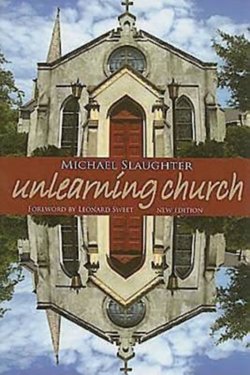Читать книгу UnLearning Church - Mike Slaughter - Страница 10
На сайте Литреса книга снята с продажи.
What's Your "One Thing"?
ОглавлениеLike those two churches I described above, unLearning churches are finding their special niche where they can connect with certain people better than any other church can. I recently visited five growing churches in Oklahoma City, each with one thousand or more in attendance, but they're all distinct in the ways they are appealing to and serving that city. They are not all trying to look like the same megachurch model. One church emphasizes the Creation. Its campus is full of waterfalls and living plants, and it sponsors a wide diversity of life-generating ministries in the community, from an eye clinic in the inner city to programs for ex-offenders. Another communicates the atmosphere of a high-class hotel, featuring a more classical appearance and reaching the upper-middle class with strong ministries to singles and blended families.
These churches may all share the same geographic area, but they are reaching distinctly different people groups. The distinctiveness of churches like these goes far beyond denominational differences and worship styles. They don't fit the same old classifications and they can't be traced to the same cookie-cutter mold. They all take a different tack, but they all excel in local implementation. They connect people in their communities or cultures to an experience of God, to authentic community, and to life purpose.
If the emerging church is recognized and valued for anything, it's for a highly effective, indigenous carrying out of the mission of Jesus Christ. This next generation of churches goes far beyond a simple name change from "Methodist" or "Baptist" to "Community Church" or "Christian Center." These churches resist such categories as traditional or contemporary; conservative or liberal; large or small; suburban, urban, or rural; and even Catholic or Protestant. They don't fit neatly into categorized boxes. Each of their hearts is to uniquely demonstrate the presence of God in their own native settings.
UnLearning churches each articulate and practice a unique call and identity. Like the four friends who brought the paralyzed man to Jesus by cutting a hole in the roof (Mark 2:3-4), these prophetic communities find creative ways to bring people to Jesus. The dominant expression of Christianity at Ginghamsburg is service. People primarily express their faith in Jesus by serving in a multitude of ways. For other churches, that unique call might be a healing ministry or the sending out of daughter churches.
The specific mission and style of your congregation won't necessarily be the same as mine or anybody else's. Try to put a finger on God's vision for your church as you experience this book. I also encourage you to make specific commitments to spiritual growth that may help you get in touch with that unique vision.
